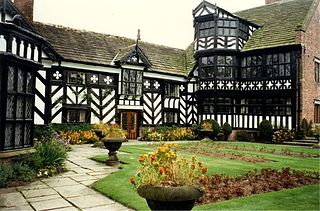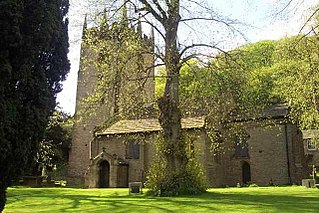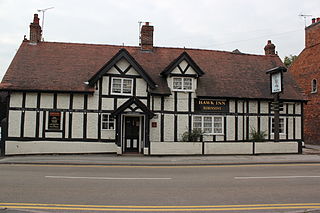
Lyme Park is a large estate located south of Disley, Cheshire. The estate is managed by the National Trust and consists of a mansion house surrounded by formal gardens, in a deer park in the Peak District National Park. The house is the largest in Cheshire, and is recorded in the National Heritage List for England as a designated Grade I listed building.

Gawsworth Old Hall is a Grade I listed country house in the village of Gawsworth, Cheshire, England. It is a timber-framed house in the Cheshire black-and-white style. The present house was built between 1480 and 1600, replacing an earlier Norman house. It was probably built as a courtyard house enclosing a quadrangle, but much of it has been demolished, leaving the house with a U-shaped plan. The present hall was owned originally by the Fitton family, and later by the Gerards, and then the Stanhopes. Since the 1930s it has been in the possession of the Richards family. Raymond Richards collected a number of items from other historic buildings and incorporated them into the hall.

St James' Church is in the village of Gawsworth, Cheshire, England, and is sited near Gawsworth Hall. It is recorded in the National Heritage List for England as a designated Grade I listed building. It is an active Anglican parish church in the diocese of Chester, the archdeaconry of Macclesfield and the deanery of Macclesfield. Clifton-Taylor includes it in his list of 'best' English parish churches. The authors of the Buildings of England series describe the church as being "pretty, but odd".

St Christopher's Church is in the small village of Pott Shrigley, Cheshire, England. The church is recorded in the National Heritage List for England as a designated Grade I listed building. It is an active Anglican parish church in the diocese of Chester, the archdeaconry of Macclesfield and the deanery of Macclesfield.

Gawsworth New Hall is a country house in the village of Gawsworth, Cheshire, England. It is recorded in the National Heritage List for England as a designated Grade II* listed building.

Gawsworth Old Rectory is a house in the village of Gawsworth, Cheshire, England. It is recorded in the National Heritage List for England as a designated Grade I listed building. The authors of the Buildings of England series express the opinion that it is "an exceptionally fine timber-framed house".
The Grade I listed buildings in Cheshire, excluding those in the city of Chester, total around 80. Almost half of these are churches that are contained in a separate list.
Alderley Old Hall is the remaining part of a former 17th-century manor house near the village of Nether Alderley, Cheshire, England. It stands adjacent to the mill pond of Nether Alderley Mill, a loop of which acts as a moat. The hall is recorded in the National Heritage List for England as a designated Grade II* listed building.

Ashley Hall is a country house standing to the north of the village of Ashley, Cheshire, England. It dates from the late 16th to the early 17th century, with additions made in the 18th and 19th centuries. The house is historically important because it was here that the Cheshire gentlemen met in 1715 to decide whether to support the Stuarts or the Hanoverians. They decided on the latter and later commissioned a set of portraits, which now hang in Tatton Hall. The house is recorded in the National Heritage List for England as a designated Grade II listed building. Also listed at Grade II are the gate piers to the forecourt of the building, a carriage house in the forecourt, the kitchen garden wall, and the stable block.
Chelford Manor House stands to the southeast of the village of Chelford, Cheshire, England. It dates from the early 17th century. An extension was made to it in 1671, and more alterations and additions were carried out in the 19th and 20th centuries. The last addition was made for Colonel Dixon of Astle Hall. The house is timber-framed on a stone plinth. The infill is either brick or rendered brick. It is roofed in slate and cement tiles. It is a "complex" building, with parts in two storeys, and other parts in three storeys. The house is recorded in the National Heritage List for England as a designated Grade II* listed building. To the north of the manor house is a former tithe barn. This is also timber-framed with brick infill, and is listed at Grade II.

Hulme Hall is a house on a moated site in the parish of Allostock, Cheshire, England. It originated in the 15th century, with additions and alterations in the 17th and 19th centuries. It is now a farmhouse. The house is constructed in brown brick, and has a roof of stone-slate and Welsh slate. It is in two storeys with an attic, and has an asymmetrical plan. The northeast front is the entrance front, and has three gabled bays. The garden front is on the northwest; it has five bays, two of which are stepped back in two stages. Most of the windows are two or three-light casements. The house is recorded in the National Heritage List for England as a designated Grade II* listed building. The bridge over the moat leading to the house is also listed at Grade II*. The moated site on which the house stands is a scheduled monument. It had been the home of the Grosvenor and Shakerley families, both of whom were prominent in Cheshire.

Sutton Hall is a former country house to the west of the village of Sutton Lane Ends, Cheshire, England.
Twemlow Hall is a country house standing on a former moated site in the parish of Twemlow, Cheshire, England. It dates from the 17th century, and was "much altered" in 1810 for William Bache Booth. It was altered again in 1974. The house is constructed in brick on a stone plinth. It has flush stone quoins and a slate roof. It has two storeys, and a symmetrical entrance front of five bays, three of which are gabled. Above the doorway are the arms of the Booth family. The windows are sashes. The house is recorded in the National Heritage List for England as a designated Grade II listed building. Three structures associated with the hall forming three sides of a former stable yard are also listed at Grade II.
Gawsworth is a civil parish in Cheshire East, England. It contains 20 buildings that are recorded in the National Heritage List for England as designated listed buildings. Of these, three are listed at Grade I, the highest grade, two are listed at Grade II*, the middle grade, and the others are at Grade II. Apart from the village of Gawsworth, the parish is rural. The most important buildings in the parish, all listed at Grade I are Gawsworth Old Hall and associated structures, St James' Church, also with associated structures, and the Old Rectory. Listed at Grade II* are Gawsworth New Hall and an associated barn. The Macclesfield Canal runs through the parish, and there are three listed structures associated with this, two bridges and a milestone. The other listed buildings are houses, farm buildings, a grave, a public house, a war memorial, and a boundary stone.

The White Lion is a public house located just off junction 16 of the M6 at Audley Road, Barthomley, Cheshire, England. It was built in 1614, and is recorded in the National Heritage List for England as a designated Grade II* listed building.

The Holly Bush is a public house at 75 Palmerston Street, Bollington, Macclesfield, Cheshire, England. It is recorded in the National Heritage List for England as a designated Grade II listed building.

The Hawk Inn is a Grade II listed public house at 137 Crewe Road, Haslington, Cheshire, CW1 5RG.
The Castle is a Grade II listed public house at 27 Church Street, Macclesfield, Cheshire, SK11 6LB.
The Plough is a Grade II listed public house at 927 Hyde Road, Gorton, Manchester M18 7FB.

The Cheshire Cheese is a public house at 5 Little Essex Street, London WC2, on the corner with Milford Lane.

















